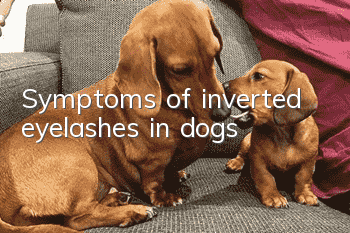Symptoms of inverted eyelashes in dogs

The main symptoms of dog inverted eyelashes include: constant scratching of the eyes, increased eye feces, constant tears, increased eye secretions, eye redness and swelling, etc. If not treated in time, inverted eyelashes will continue to irritate the dog's eyes, including the eye mucosa, cornea, etc., which can easily cause eye infections, corneal ulcers and other diseases. In severe cases, it can also lead to blindness in the dog's eyes.
1. Reasons why dogs have inverted eyelashes
Troubled eyelashes in dogs may be caused by genetic or breed reasons. Dogs with trichotic eyelashes can easily pass on their trichophilic eyelashes to the next generation, and some puppies may be born with triangular eyelashes. In addition, some individuals such as French Bulldogs, English Bulldogs, Pekingeses, English Cocker Spaniels, Miniature Poodles, Shih Tzus, Golden Retrievers, and Dachshunds will only develop tricholashes after adulthood.
2. How to deal with inverted eyelashes in dogs
1.Surgical treatment
Dog inverted eyelashes are mainly treated through surgical treatment. It is recommended to take the dog to the pet hospital for relevant examination and treatment in time. After surgical treatment, the dog needs to wear an Elizabethan ring to prevent the dog from scratching its eyes. At the same time, you should continue to use pet-specific anti-inflammatory eye drops for a period of time to prevent secondary infections after surgery.
2. Use tweezers to remove inverted eyelashes
If your dog has fewer inverted eyelashes, you can also use tweezers to remove the inverted eyelashes, and the effect will be immediate. However, this method treats the symptoms rather than the root cause, and the inverted eyelashes will still grow back.
3.Electrolysis method
In order to avoid the regeneration of inverted eyelashes, electrolysis can also be used to destroy the hair follicles. This is also the most thorough method. However, if this method is handled by yourself, the risk will be very high, so it is still recommended to go to a professional pet hospital for treatment.
- Causes of loss of appetite in dogs
- Why do dogs like to eat shit?
- How to train a two-month-old Samoyed? Discuss how to raise a Samoyed!
- What should I do if my dog vomits?
- How to prevent ticks on dogs
- How many days does it take to start training a German Shepherd? You will know after reading this!
- Dog training methods and teach you how to communicate with your dog!
- What should I do if my horse-dog doesn’t bark? Can it be trained?
- Is it okay to use Beveto to deworm dogs externally?
- Causes and treatments of pyoderma in dogs



